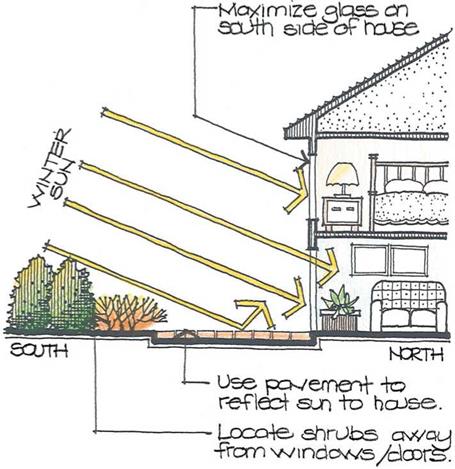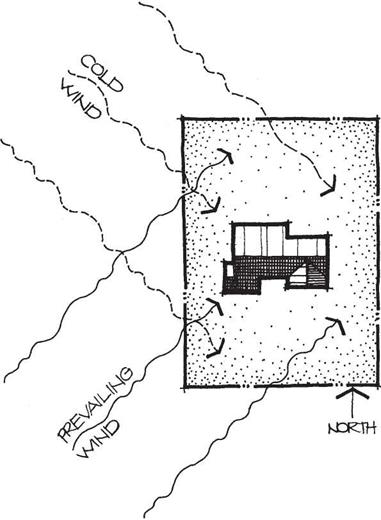 |
 |
Wind is another climatic factor that must be considered when designing a residential site. Wind affects both human comfort and energy consumption of the house itself. Wind cools the body by increasing the amount of moisture evaporated at the skin’s surface. This is desired when air temperatures exceed the comfort range of 70 to 80°F. When this occurs, wind functions like a fan to cool the body, making it feel cooler
than the ambient air temperature. On the other hand, wind exposure is not desired when air temperatures drop below 70°F. Wind accentuates the perception of cold air at these temperatures and creates what is commonly called “wind chill.” Similar phenomena occur for the house itself. Wind carries away the heat of the house and affects the amount of energy required for heating and cooling.
Unlike sun, wind is not as precisely predictable. Wind is more variable on a daily basis than sun but does hold to some generalized patterns based on season and weather fronts. In broad terms, wind blows from all compass directions throughout the year. However, wind blows most commonly from a westerly direction throughout the United States. In the summer, the prevailing wind is from the south and southwest, and during the cool season it shifts more to the west and northwest (Figure 3—26). The wind direction also responds to weather fronts. For example, wind originates mostly from the south and southwest during a warm front but shifts to the northwest following the passage of a cold front. These general patterns are further modified by the presence of mountain ranges and large water bodies. It is best to refer to weather records kept by the National Weather Service to obtain more precise readings of wind direction in any given geographic setting.
Some broad patterns of wind are evident during the four seasons of the year for an open, level site surrounding a two-story house located in the temperate zone:
 |
• All sides of the house are exposed to wind at some time during the course of the year.
• The south, southwest, and west sides of the house receive the most constant wind on a yearly basis.
• The south and west sides of a house are generally the most exposed to wind during the summer months and/or during a warm front.
• The north and west sides of a house are most exposed to the cooling effects of winds following the passage of a cold front; this outcome is most negative during the winter season.
• The eastern side of the house is the most protected from the wind during the year.
Topography, vegetation, and other buildings both on and off a particular site frequently modify these general conditions. It is essential that the nearby off-site conditions be studied to determine how wind will be affected in its flow. For example, Figure 3—27 illustrates how different locations of houses and vegetation on adjoining properties influence where wind is either concentrated or screened from a site.
Two overall recommendations for designing with wind on a residential site are: (1) protection is needed for winds blowing from the west and northwest and (2) exposure is desired for winds blowing from the south and southwest. These objectives apply both for outdoor spaces and for the house itself.



